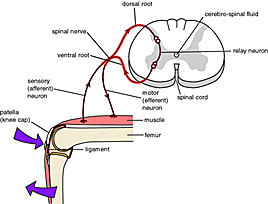
The mechanism of the reflex arc
A reflex action is a stereotyped (involuntary) motor response elicited by a defined stimulus. 1 A reflex action is mediated via the reflex arc.
Explanation
A reflex action or reflex is a biological control system linking stimulus to response and mediated by a reflex arc. Reflexes can be built-in or learned. It occurs very quickly before thinking. Before the message is sent to the brain the spine picks it up and sends it back to the muscle causing spasm.
Simple reflex
A simple reflex is entirely automatic and involves no learning. {Biopsy}} An example is the escape reflex (e.g., the sudden withdrawal of a hand in response to a pain stimulus), or the patellar reflex (the jerking of a leg when the kneecap is tapped). Sensory cells (receptors) in the stimulated body part send signals to the spinal cord along a sensory nerve cell. Within the spine a reflex arc switches the signals straight back to the muscles of the body (in this case the arm or the leg) (effectors) via an intermediate nerve cell and then a motor nerve cell; contraction of the leg occurs, and the muscle contracts (the arm or leg jerks upwards). Only three nerve cells are involved, and the brain is only aware of the response after it has taken place. Such reflex arcs are particularly common in animals, and have a high survival value, enabling organisms to take rapid action to avoid potential danger.
Conditioned reflex
A conditioned reflex involves the modification of a reflex action in response to experience (learning). A stimulus that produces a simple reflex response becomes linked with another, possibly unrelated, stimulus. For example, a dog may salivate (a reflex action) when it sees its owner remove a tin-opener from a drawer because it has learned to associate that stimulus with the stimulus of being fed.
Reaction time
For a reflex, reaction time or latency is the time from the onset of a stimulus until the organism responds.
Human reflexes
Reflex actions seen in adult humans include:
- Accommodation reflex
- Achilles reflex
- Anocutaneous reflex
- Babinski reflex
- Biceps stretch reflex
- Brachioradialis reflex
- Corneal reflex
- Crossed extensor reflex
- Mammalian diving reflex
- Gag reflex
- Gastroc-Soleus reflex
- H-reflex
- Patellar reflex (knee-jerk reflex)
- Photic sneeze reflex
- Pupillary reflex
- Quadriceps reflex
- Salivation
- Scratch reflex
- Sneeze
- Tendon reflex
- Triceps stretch reflex
- Vestibulo-ocular reflex
- Withdrawal reflex
Processes such as breathing, digestion and the maintenance of the heartbeat can also be regarded as reflex actions, according to some definitions of the term.
Newborn babies have a number of other reflexes which are not seen in adults, including:
- suckling
- hand-to-mouth reflex
- Moro reflex, also known as the startle reflex
- grasp reflex
- Asymmetrical tonic neck reflex (ATNR)
- Symmetrical tonic neck reflex (STNR)
- Tonic labyrinthine reflex (TLR)
Significance
The deep tendon reflexes provide information on the integrity of the central and peripheral nervous system. Generally, decreased reflexes indicate a peripheral problem, and lively or exaggerated reflexes a central one.
See also
- Automatism
- Automatism (case law)
- Autonomic nervous system
- Toss juggling: Reflexes - (development of higher-order conditioned reflex actions)
- Sensory system
- Spinal nociceptive reflex
- Tonic vibration reflex
- Voluntary action
External links
References
Note 1: Purves (2004). Neuroscience: Third Edition. Massachusetts, Sinauer Associates, Inc.
ca:Reacció reflexa de:Reflex (Physiologie) he:רפלקס nl:Reflex (biologie) ru:Рефлекс (биология) fi:Refleksi sv:Reflex (medicinsk term)
| This page uses Creative Commons Licensed content from Wikipedia (view authors). |
}